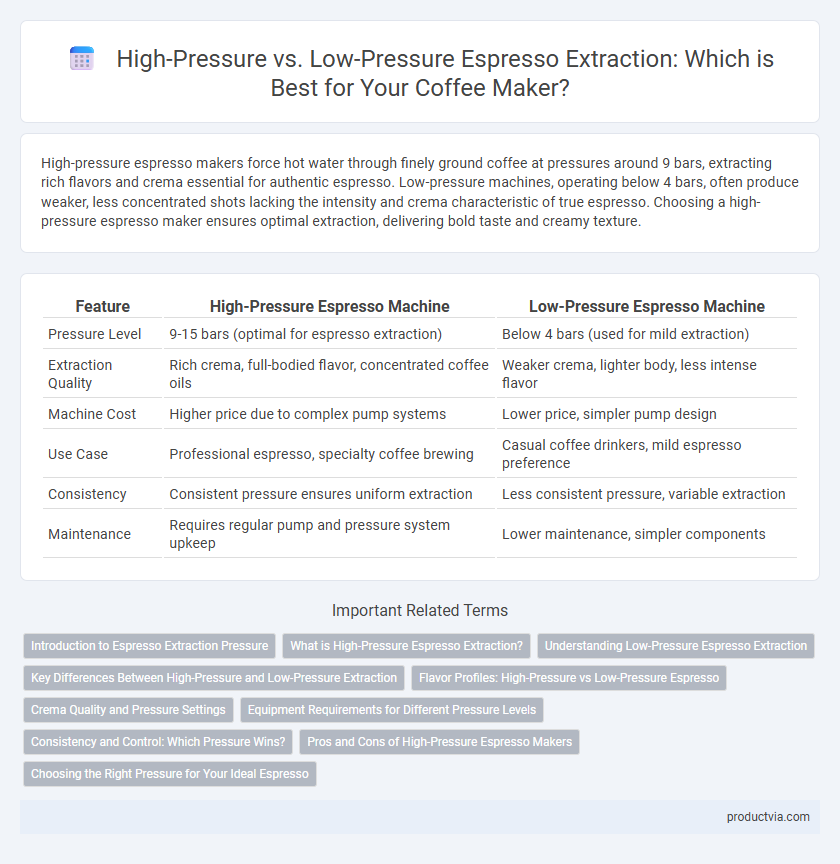High-pressure espresso makers force hot water through finely ground coffee at pressures around 9 bars, extracting rich flavors and crema essential for authentic espresso. Low-pressure machines, operating below 4 bars, often produce weaker, less concentrated shots lacking the intensity and crema characteristic of true espresso. Choosing a high-pressure espresso maker ensures optimal extraction, delivering bold taste and creamy texture.
Table of Comparison
| Feature | High-Pressure Espresso Machine | Low-Pressure Espresso Machine |
|---|---|---|
| Pressure Level | 9-15 bars (optimal for espresso extraction) | Below 4 bars (used for mild extraction) |
| Extraction Quality | Rich crema, full-bodied flavor, concentrated coffee oils | Weaker crema, lighter body, less intense flavor |
| Machine Cost | Higher price due to complex pump systems | Lower price, simpler pump design |
| Use Case | Professional espresso, specialty coffee brewing | Casual coffee drinkers, mild espresso preference |
| Consistency | Consistent pressure ensures uniform extraction | Less consistent pressure, variable extraction |
| Maintenance | Requires regular pump and pressure system upkeep | Lower maintenance, simpler components |
Introduction to Espresso Extraction Pressure
Espresso extraction relies heavily on the pressure exerted during brewing, with high-pressure machines typically operating around 9 bars to force water through finely ground coffee, resulting in rich crema and intense flavor. Low-pressure systems, often below 4 bars, tend to produce a milder extraction, which can lack the concentration and crema characteristic of true espresso. Understanding the impact of pressure on extraction quality is essential for selecting the right coffee maker to achieve authentic espresso.
What is High-Pressure Espresso Extraction?
High-pressure espresso extraction uses a pump to force hot water through finely ground coffee at approximately 9 bars of pressure, producing a rich and concentrated shot with a thick crema. This method ensures optimal flavor extraction by rapidly dissolving coffee oils and soluble compounds, resulting in a balanced and intense espresso. High-pressure machines, such as those with electric pumps, are standard in professional and premium home espresso makers for consistent quality.
Understanding Low-Pressure Espresso Extraction
Low-pressure espresso extraction typically occurs at pressures around 4 to 6 bars, compared to the standard 9 bars used in high-pressure methods. This lower pressure accentuates subtle flavor profiles and enhances the natural sweetness of the coffee without forcing excessive bitterness or harshness. Machines designed for low-pressure extraction often produce a smoother, more balanced espresso shot, ideal for those seeking a nuanced and gentle coffee experience.
Key Differences Between High-Pressure and Low-Pressure Extraction
High-pressure espresso machines operate at around 9 bars of pressure, forcing water through finely-ground coffee to extract rich flavors and a thick crema, while low-pressure machines use less than 4 bars, resulting in a milder taste and less crema production. The increased pressure in high-pressure extraction enhances the solubility of coffee compounds, producing a more concentrated and intense espresso shot. Low-pressure extraction often suits pour-over or drip coffee methods, emphasizing balanced flavors over the bold intensity characteristic of traditional espresso.
Flavor Profiles: High-Pressure vs Low-Pressure Espresso
High-pressure espresso machines, typically operating at 9 bars or more, extract concentrated and intense flavors, producing rich crema and a bold taste profile favored by traditional espresso enthusiasts. Low-pressure extraction, often under 4 bars, results in a smoother, milder cup with enhanced clarity and subtle acidity, highlighting nuanced coffee origins and delicate aromas. Choosing between high-pressure and low-pressure espresso influences flavor balance, body, and crema quality, tailoring the sensory experience to individual preferences.
Crema Quality and Pressure Settings
High-pressure espresso machines, typically operating at 9 bars or more, extract richer crema with fine microbubbles and enhanced flavor complexity by forcing water through finely ground coffee under optimal pressure. Low-pressure machines, usually below 6 bars, produce thinner crema with larger bubbles, resulting in weaker body and less aromatic intensity. Precise pressure settings directly impact crema quality, making 9-bar pressure a critical standard for authentic, robust espresso extraction.
Equipment Requirements for Different Pressure Levels
High-pressure espresso machines typically require a robust pump system capable of generating 9 bars or more, essential for optimal extraction of coffee oils and flavors. Low-pressure espresso machines operate around 3 to 5 bars and often use simpler, less powerful pumps, resulting in a different flavor profile and body. Equipment designed for high-pressure extraction demands durable components and pressure-resistant seals to maintain consistent performance under intense pressure conditions.
Consistency and Control: Which Pressure Wins?
High-pressure espresso machines, typically operating around 9 bars, ensure consistent extraction by maintaining stable pressure throughout the brewing process, resulting in a rich crema and balanced flavor profile. Low-pressure systems, often below 4 bars, offer greater control for manual adjustments but risk inconsistent extraction and weaker crema due to fluctuating pressure levels. For reliable espresso consistency and optimal control over extraction variables, high-pressure machines generally outperform their low-pressure counterparts.
Pros and Cons of High-Pressure Espresso Makers
High-pressure espresso makers, typically operating at 9 bars or more, excel at extracting rich flavors and producing a thick crema, enhancing the overall espresso quality. However, these machines can be expensive, require precise grind settings, and may lead to over-extraction if pressure is not carefully controlled. Low-pressure espresso makers often deliver a milder taste and simpler maintenance but lack the intense flavor and crema produced by high-pressure systems.
Choosing the Right Pressure for Your Ideal Espresso
High-pressure espresso machines, typically operating at 9 bars or more, extract rich flavors quickly, creating a robust crema and intense aroma ideal for traditional espresso lovers. Low-pressure extraction, often around 4 to 6 bars, allows a gentler water flow that enhances delicate flavor notes and reduces bitterness, preferred in manual or pour-over styles. Selecting the right pressure involves balancing intensity and flavor complexity to match individual taste preferences and the specific coffee bean profile.
High-pressure vs Low-pressure for espresso extraction Infographic

 productvia.com
productvia.com